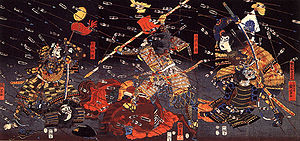
Kusunoki Masatsura
Encyclopedia

, along with his father Masashige
Kusunoki Masashige
was a 14th century samurai who fought for Emperor Go-Daigo in his attempt to wrest rulership of Japan away from the Kamakura shogunate and is remembered as the ideal of samurai loyalty.-Tactician:...
and brother Masanori
Kusunoki Masanori
was a samurai who fought for the Southern Court in Japan's Nanboku-chō Wars, and is famed for his skills as a leader and military strategist, though he later sought a diplomatic solution and was regarded a traitor by many of his comrades...
, was a supporter of the Southern Imperial Court during Japan's Nanbokucho Wars
Nanboku-cho
The , spanning from 1336 to 1392, was a period that occurred during the formative years of the Muromachi bakufu of Japan's history.During this period, there existed a Northern Imperial Court, established by Ashikaga Takauji in Kyoto, and a Southern Imperial Court, established by Emperor Go-Daigo in...
.
Masatsura was one of the primary military leaders who revived the Southern Court in the 1340s. The Court had had little to no resources for three years; the strategy was too focused on defending their base at Yoshino, and not on gaining allies, land, or income. The Kusunoki family, and Masatsura in particular, fought to gain power and support for the Emperor. In 1347, Masatsura led an attack on bakufu (shogunate
Ashikaga shogunate
The , also known as the , was a Japanese feudal military regime, ruled by the shoguns of the Ashikaga clan.This period is also known as the Muromachi period and gets its name from Muromachi Street of Kyoto where the third shogun Ashikaga Yoshimitsu established his residence...
) sympathizers in Kii Province
Kii Province
, or , was a province of Japan in the part of Honshū that is today Wakayama Prefecture, as well as the southern part of Mie Prefecture. Kii bordered Ise, Izumi, Kawachi, Shima, and Yamato Provinces. The Kii Peninsula takes its name from this province....
and ended up attracting supporters from Kii, as well as Izumi
Izumi Province
was a province of Japan. It is also referred to as . It lay in Kinai, and its area today composes the south-western part of Osaka Prefecture . The Ōshōji in Sakai was the border with Settsu Province, until the beginning of the Meiji period, when the boundary was changed to be at the Yamato River...
and Settsu
Settsu Province
was a province of Japan, which today comprises the eastern part of Hyōgo Prefecture and the northern part of Osaka Prefecture. It was also referred to as or .Osaka and Osaka Castle were the main center of the province.-History:...
Provinces. When the Shogun's Northern Court
Northern Court (Japan)
The , also known as the "Ashikaga Pretenders" or "Northern Pretenders", were a set of six pretenders to the throne of Japan during the Nanboku-chō period from 1336 through 1392...
sent Hosokawa Akiuji
Hosokawa Akiuji
was a samurai general in the service of the Ashikaga Northern Court, during Japan's Nanboku-chō period.In 1338, he was sent by Ashikaga Takauji to assist in the defence of the Kuromaru, a fortress belonging to Kanrei Shiba Takatsune. His men clashed with fifty horsemen under the command of Nitta...
to stop him, Masatsura met Hosokawa and defeated him in the battle of Sakainoura.
After several more campaigns against the bakufu, Masatsura was killed in the Battle of Shijō Nawate
Battle of Shijo Nawate
The 1348 Battle of Shijōnawate was a battle of the Nanboku-chō period of Japanese history, and took place in Yoshinoko, Japan. It was fought between the armies of the Northern and Southern Emperors of Japan. The Southern army, led by Kusunoki Masatsura was attacked at Yoshino, the temporary palace...
, in February 1348 at the age of 22. Before he died, he composed a death poem
Death poem
A death poem is a poem written near the time of one's own death. It is a tradition for literate people to write one in a number of different cultures, especially in Joseon Korea and Japan.-History:...
:
- 帰へらじと
- 兼ねて思へば
- 梓弓
- 亡き数に入る
- 名をぞとどむる
- kaeraji to
- kanete omoeba
- azusayumi
- nakikazu ni iru
- na wo zotodomuru
- I have a feeling
- I will not be returning,
- so among the names
- of those who died by the bow
- I inscribe my own.
Cultural references
In Equinox FlowerEquinox Flower
is a 1958 color Japanese film directed by Yasujiro Ozu. It is Yasujiro Ozu's first film in color while Japan's first color film, Keisuke Kinoshita's Carmen Comes Home, had been released in 1951. The film is based on a novel by Ton Satomi...
(彼岸花 ,Higanbana), a 1958 color Japanese film directed by Yasujirō Ozu
Yasujiro Ozu
was a prominent Japanese film director and script writer. He is known for his distinctive technical style, developed during the silent era. Marriage and family, especially the relationships between the generations, are among the most persistent themes in his body of work...
, one of the characters declaims a poet "based on a death poem of patriot Kusunoki Masatsura". Whether it has to do with the precious poem is unknown.
An approximate translation is :
- My father's precepts are engraved in my heart.
- I will faithfully follow the emperor's edict.
- 10 years of patience, and finally the time has come.
- Strike a powerful blow
- for the emperor's cause we are struggling now.
- To fight and die as men, we make an oath.
- We, 143 companions of war, united as one,
- determined to fight until victory, yes, we are.
- By dying, heroes earn an immortal glory,
- the cowards suffer an eternal shame.
- With the edges of our arrows, we engrave our story,
- the blades of our swords shine in the evening.
- Against the approaching enemy, let's walk with the same step,
- At their general, let's give the final blow.

